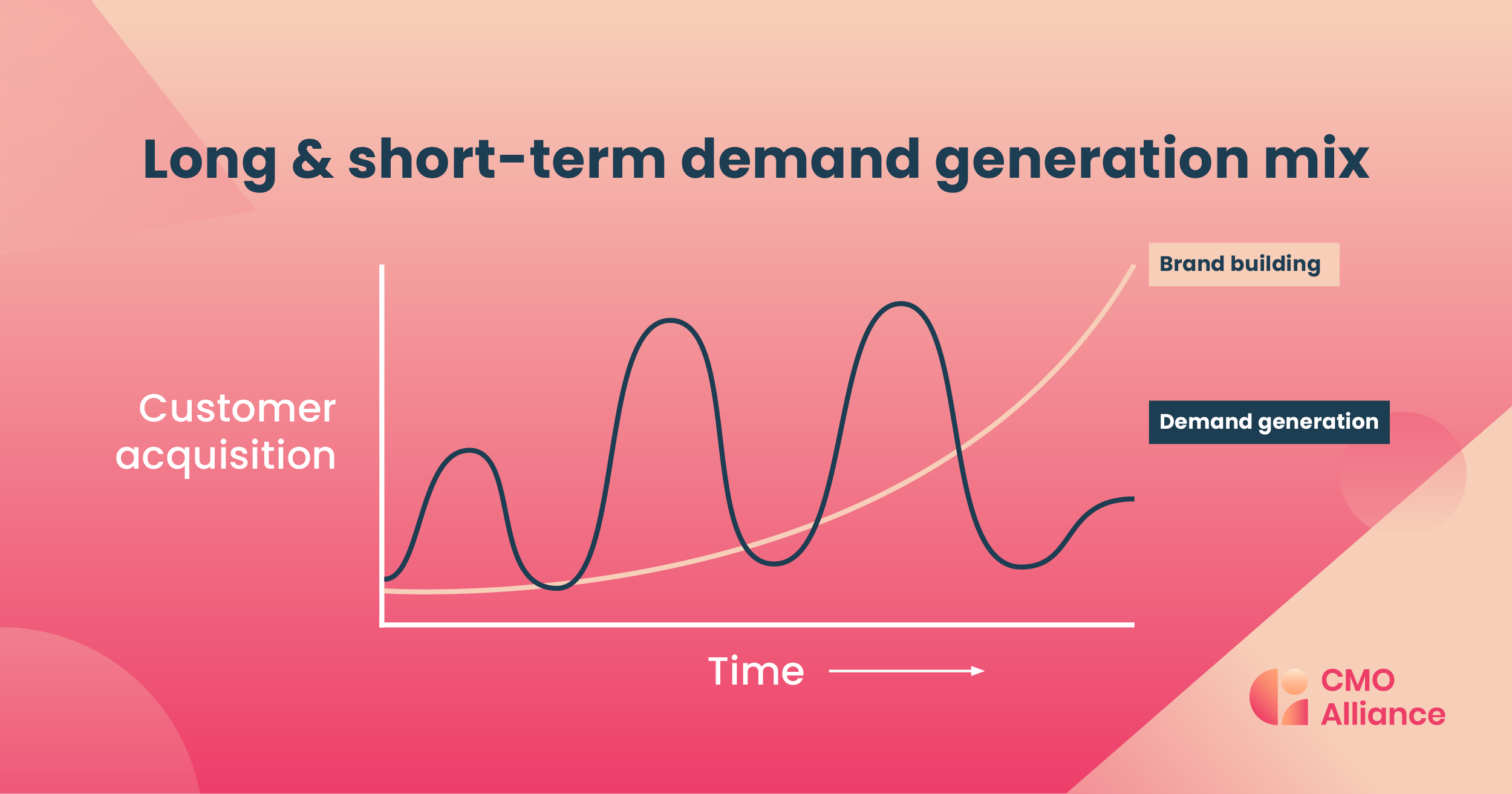More and more, B2B marketing leaders are intensely focused on immediate return on investment (ROI). In an environment defined by budget constraints and economic downturns, there's a strong demand for accountability and measurable results. Every dollar invested in marketing must show a direct correlation with revenue, preferably in the short term.
This focus also stems from the pressure to justify marketing expenditures to other parts of the organization, including finance and top management. By demonstrating an immediate ROI, marketers can provide tangible evidence of their campaigns' success and defend their budget allocations.
Moreover, in a fast-paced, digitally driven marketplace, there's often an expectation that marketing campaigns should produce instant results. Tools for tracking online behavior and responses to specific ads have reinforced the notion that marketing can, and should, bring about swift sales. A widely held misperception suggests that marketing operates predominantly through the art of persuasion, pushing buyers along a sales funnel by presenting them with compelling product benefits and enticing explanations.
Unfortunately, this heavy emphasis on demand and immediate ROI can often detract from brand-building efforts, which are essential for long-term growth and sustainability. These efforts, which foster customer loyalty and awareness, often take a longer period to yield measurable results. Consequently, they may be deprioritized in the face of demands for immediate returns.
What's crucial to understand is that not all potential customers are ready to purchase right away. In fact, research suggests that a staggering 95% of potential buyers may be out-of-market at any given time, and are unlikely to buy until much later.
The insistence on rapid results fails to consider this significant group of out-of-market buyers, who require consistent, longer-term engagement to eventually convert them into customers. Hence, the focus on quick wins, at the expense of a long-term view, can lead to missed opportunities and could limit the overall effectiveness of B2B marketing strategies.

The dilemma of Demand vs Brand
Brand-building plays a significant role in future-proofing a business. By constantly reinforcing the brand message and its associated value, companies can ensure they are top-of-mind when customers eventually decide they are in the market for a product or service, which in B2B sectors can often take months or even years.
Building a strong brand is crucial for long-term success as it extends beyond immediate transactions and cultivates enduring relationships with customers, prospects, and partnerships. A strong brand acts as a beacon of trust and quality, distinguishing a company from its competitors. In an era where customers are inundated with choices, a robust brand can effectively cut through the noise and capture customers' attention.
Furthermore, a strong brand isn't just recognized—it's preferred. It engenders loyalty, often leading to repeat purchases and long-term customer relationships. The emotional connection that a strong brand can create goes beyond the capabilities of the product or service, making it less susceptible to price wars or minor differences in features among competitors.
Finally, a strong brand tends to attract quality employees, partnerships, and even investors, further propelling a company toward sustainable success. In essence, while building a brand may not offer immediate returns in the same way that direct response marketing does, its long-term value is significant and far-reaching.
Balancing act: navigating quick wins and long-term branding strategies
Balancing short-term goals with long-term branding strategy requires a holistic, nuanced approach. Here are a few strategies that companies can employ to help balance the mindset between the two.
Dual-Track Approach
One practical way to maintain balance is by employing a dual-track approach, where resources are allocated to both short-term performance marketing and long-term brand building. For example, a portion of the marketing budget can be devoted to performance-driven activities like pay-per-click advertising, email marketing, or conversion rate optimization to drive immediate results. Simultaneously, another portion can be allocated to long-term brand-building activities such as content marketing, SEO, public relations, and community outreach.
Segmented Goals
Another strategy is setting both short-term and long-term goals. Short-term goals can be designed to generate immediate ROI, while long-term goals should focus on building brand reputation and customer loyalty. Regular monitoring and reviewing of these goals can ensure a balanced approach.
Customer Lifetime Value (CLV)
Businesses should focus not just on immediate sales but also on Customer Lifetime Value. This approach encourages investing in long-term strategies like customer relationship management, customer satisfaction, and loyalty programs, which contribute to brand building and yield returns over a longer period.
Here are a few practical strategies that businesses can prioritize in their marketing programs to strike a balance between quick wins and long-term brand building:
- Content Marketing: High-quality, valuable content can help generate leads in the short term while establishing the business as a trusted authority in its field over time. Regular blog posts, white papers, case studies, or webinars can drive immediate traffic and engagement, while also contributing to SEO and brand visibility in the long run.
- Social Media Engagement: Active participation on social media platforms allows businesses to respond to customer inquiries quickly, run time-sensitive promotions, and create instant buzz. Over time, consistent and authentic interaction can foster a strong brand community and deepen customer relationships.
- Influencer Marketing: Partnering with influencers for short-term campaigns can result in an immediate increase in brand awareness and sales. If chosen wisely, these influencers can embody the brand's values and personality, helping to strengthen its image over the longer term.
- Email Marketing: Email marketing can offer immediate returns through targeted promotions and direct calls to action. By nurturing the subscribers with personalized and valuable content over time, businesses can also build lasting relationships and loyalty.
- Customer Experience Enhancement: Improving user experience on your website or product can lead to immediate increases in conversion rates, while also building a reputation as a user-friendly, customer-focused brand.
- SEO: While SEO is typically a long-term strategy, focusing on "quick win" aspects like technical SEO and long-tail keywords can bring about quicker traffic increases, while also setting up for sustained organic growth.
- Cause Marketing: By aligning with a cause or a charity, brands can create immediate goodwill and PR, while also building a brand image that resonates with their customers' values in the long run.

Other ideas for the future
Integrating Artificial Intelligence (AI) into the marketing mix is another effective approach. Leveraging AI's predictive analytics capabilities helps identify "quick win" opportunities by analyzing data on customer behavior, market trends, and campaign performance.
AI can optimize decision-making, automate processes, and deliver personalized marketing messages in real-time, leading to immediate engagement and sales. Simultaneously, AI-powered chatbots and virtual assistants provide instant customer service, cultivating a customer-centric brand image and freeing up resources for strategic, long-term initiatives.
To cultivate a flourishing brand, it is imperative to adopt a strategic mindset that extends beyond the immediate market. In our pursuit of brand growth, we must proactively engage individuals who may not currently be in the market for our offerings. By targeting this broader audience, we can lay the foundation of familiarity and establish brand recognition.
Consequently, when these individuals are ready, our brand will already have made a lasting impression. Embracing this forward-thinking approach allows us to influence not only present perceptions but also future purchasing decisions.
Are you struggling to balance quick wins vs long-term goals? Maybe you've found the ultimate way to get stakeholders aligned with investing in brand? Share your questions and insights with a global network of CMOs and marketing leaders on the CMO Alliance Community Slack channel.




 Follow us on LinkedIn
Follow us on LinkedIn




